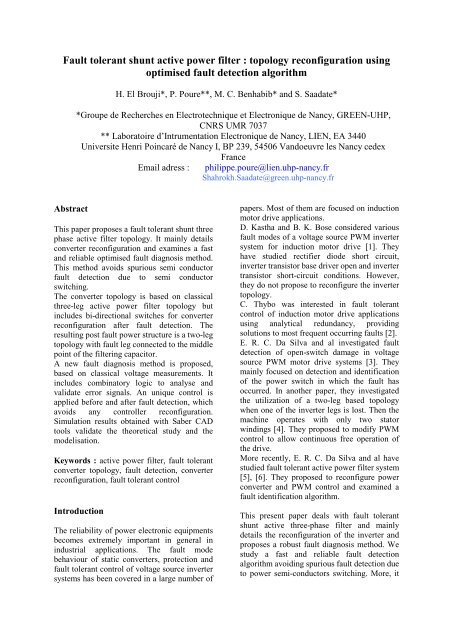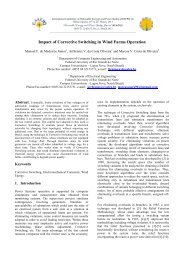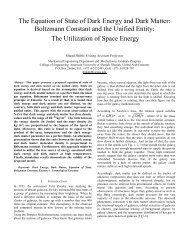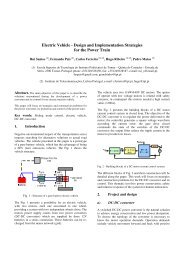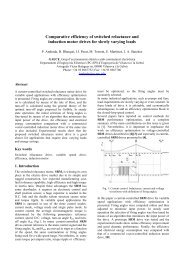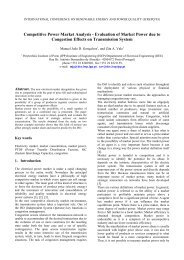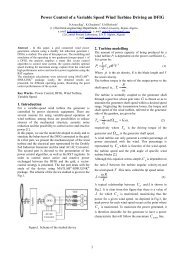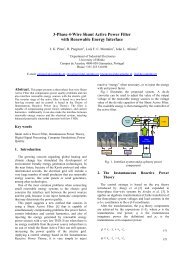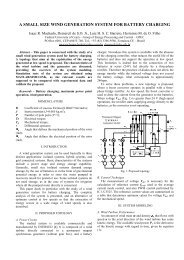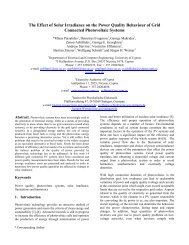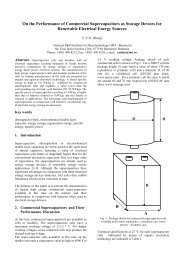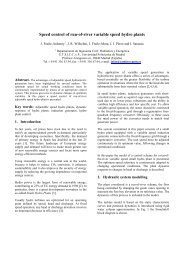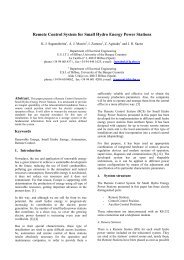Fault tolerant shunt active power filter : topology ... - Icrepq.com
Fault tolerant shunt active power filter : topology ... - Icrepq.com
Fault tolerant shunt active power filter : topology ... - Icrepq.com
You also want an ePaper? Increase the reach of your titles
YUMPU automatically turns print PDFs into web optimized ePapers that Google loves.
<strong>Fault</strong> <strong>tolerant</strong> <strong>shunt</strong> <strong>active</strong> <strong>power</strong> <strong>filter</strong> : <strong>topology</strong> reconfiguration using<br />
optimised fault detection algorithm<br />
H. El Brouji*, P. Poure**, M. C. Benhabib* and S. Saadate*<br />
*Groupe de Recherches en Electrotechnique et Electronique de Nancy, GREEN-UHP,<br />
CNRS UMR 7037<br />
** Laboratoire d’Intrumentation Electronique de Nancy, LIEN, EA 3440<br />
Universite Henri Poincaré de Nancy I, BP 239, 54506 Vandoeuvre les Nancy cedex<br />
France<br />
Email adress : philippe.poure@lien.uhp-nancy.fr<br />
Shahrokh.Saadate@green.uhp-nancy.fr<br />
Abstract<br />
This paper proposes a fault <strong>tolerant</strong> <strong>shunt</strong> three<br />
phase <strong>active</strong> <strong>filter</strong> <strong>topology</strong>. It mainly details<br />
converter reconfiguration and examines a fast<br />
and reliable optimised fault diagnosis method.<br />
This method avoids spurious semi conductor<br />
fault detection due to semi conductor<br />
switching.<br />
The converter <strong>topology</strong> is based on classical<br />
three-leg <strong>active</strong> <strong>power</strong> <strong>filter</strong> <strong>topology</strong> but<br />
includes bi-directional switches for converter<br />
reconfiguration after fault detection. The<br />
resulting post fault <strong>power</strong> structure is a two-leg<br />
<strong>topology</strong> with fault leg connected to the middle<br />
point of the <strong>filter</strong>ing capacitor.<br />
A new fault diagnosis method is proposed,<br />
based on classical voltage measurements. It<br />
includes <strong>com</strong>binatory logic to analyse and<br />
validate error signals. An unique control is<br />
applied before and after fault detection, which<br />
avoids any controller reconfiguration.<br />
Simulation results obtained with Saber CAD<br />
tools validate the theoretical study and the<br />
modelisation.<br />
Keywords : <strong>active</strong> <strong>power</strong> <strong>filter</strong>, fault <strong>tolerant</strong><br />
converter <strong>topology</strong>, fault detection, converter<br />
reconfiguration, fault <strong>tolerant</strong> control<br />
Introduction<br />
The reliability of <strong>power</strong> electronic equipments<br />
be<strong>com</strong>es extremely important in general in<br />
industrial applications. The fault mode<br />
behaviour of static converters, protection and<br />
fault <strong>tolerant</strong> control of voltage source inverter<br />
systems has been covered in a large number of<br />
papers. Most of them are focused on induction<br />
motor drive applications.<br />
D. Kastha and B. K. Bose considered various<br />
fault modes of a voltage source PWM inverter<br />
system for induction motor drive [1]. They<br />
have studied rectifier diode short circuit,<br />
inverter transistor base driver open and inverter<br />
transistor short-circuit conditions. However,<br />
they do not propose to reconfigure the inverter<br />
<strong>topology</strong>.<br />
C. Thybo was interested in fault <strong>tolerant</strong><br />
control of induction motor drive applications<br />
using analytical redundancy, providing<br />
solutions to most frequent occurring faults [2].<br />
E. R. C. Da Silva and al investigated fault<br />
detection of open-switch damage in voltage<br />
source PWM motor drive systems [3]. They<br />
mainly focused on detection and identification<br />
of the <strong>power</strong> switch in which the fault has<br />
occurred. In another paper, they investigated<br />
the utilization of a two-leg based <strong>topology</strong><br />
when one of the inverter legs is lost. Then the<br />
machine operates with only two stator<br />
windings [4]. They proposed to modify PWM<br />
control to allow continuous free operation of<br />
the drive.<br />
More recently, E. R. C. Da Silva and al have<br />
studied fault <strong>tolerant</strong> <strong>active</strong> <strong>power</strong> <strong>filter</strong> system<br />
[5], [6]. They proposed to reconfigure <strong>power</strong><br />
converter and PWM control and examined a<br />
fault identification algorithm.<br />
This present paper deals with fault <strong>tolerant</strong><br />
<strong>shunt</strong> <strong>active</strong> three-phase <strong>filter</strong> and mainly<br />
details the reconfiguration of the inverter and<br />
proposes a robust fault diagnosis method. We<br />
study a fast and reliable fault detection<br />
algorithm avoiding spurious fault detection due<br />
to <strong>power</strong> semi-conductors switching. More, it
allows to <strong>com</strong>pensate the fault as fast as<br />
possible to avoid, after its occurrence, the<br />
occurrence of a secondary fault.<br />
First, a fault <strong>tolerant</strong> inverter based on standard<br />
three-phase <strong>power</strong> structure is presented. <strong>Fault</strong><br />
diagnosis is detailed. Then, <strong>shunt</strong> <strong>active</strong> <strong>filter</strong><br />
control is presented for three-leg and two-leg<br />
structures. The major advantage of this control<br />
principle is to be suited if there is fault or not.<br />
Finally, we present simulation results<br />
illustrating fault diagnosis and control<br />
developed in the present paper.<br />
I. System description<br />
point O of the capacitor C dc . Consequently,<br />
triacs allow reconfiguring the inverter module<br />
after the fault diagnosis. By this way, for the<br />
leg number k, if one of the semi-conductor T i<br />
or its associated switch driver is faulty, the leg<br />
including T i could be isolated and the point k<br />
directly connected to the middle point 0 by<br />
switching on the triac T rk .<br />
r s<br />
e s2<br />
e s3<br />
l s<br />
l s<br />
r s<br />
r s<br />
i s2<br />
i s3<br />
e s1<br />
i s1<br />
i f1<br />
i f2<br />
i f3<br />
l c<br />
l c<br />
l c<br />
r c<br />
r c<br />
r c<br />
i c1<br />
i c2<br />
i c3<br />
L<br />
R<br />
Fig. 1 presents a classical three-leg <strong>shunt</strong><br />
<strong>active</strong> <strong>power</strong> system. It is <strong>com</strong>posed of a grid<br />
(e si for i = {1, 2, 3}), a non-linear load, a<br />
voltage source converter. The load is a threephase<br />
diode rectifier feeding a series (R, L)<br />
load. The grid is supposed to be balanced with<br />
equal series resistances r s and inductances l s for<br />
each phase. The static converter is a voltage<br />
source inverter with equal series resistances r f<br />
and inductances l f for each phase.<br />
l s<br />
T 3<br />
f 1 f 2 f 3<br />
T 1 T 2<br />
1<br />
2<br />
3<br />
T 4 T 5<br />
T 6<br />
f 4 f 5 f 6<br />
r f<br />
e s1<br />
r f<br />
l f<br />
l f<br />
l f<br />
C dc V<br />
T dc 2<br />
r1<br />
T r2<br />
T r3<br />
O<br />
C dc V dc 2<br />
l s<br />
r s<br />
e s2<br />
e s3<br />
l s<br />
l s<br />
r s<br />
r s<br />
i s2<br />
i s3<br />
e s1<br />
i s1<br />
i f3 i f2<br />
i f1<br />
T 1<br />
T 6<br />
r f<br />
r f<br />
T 4<br />
l f<br />
l f<br />
l f<br />
T 1<br />
T 2 T 3<br />
V dc<br />
1<br />
C dc<br />
2<br />
3<br />
T 5<br />
l c<br />
l c<br />
l c<br />
r c<br />
r c<br />
r c<br />
i c1<br />
i c2<br />
Fig.1 : Classical three-leg <strong>shunt</strong> <strong>active</strong> <strong>filter</strong><br />
<strong>topology</strong>.<br />
The output currents of the <strong>shunt</strong> <strong>active</strong> <strong>filter</strong><br />
are controlled to provide re<strong>active</strong> <strong>power</strong> and<br />
harmonic currents generated by the non-linear<br />
load to ensure <strong>filter</strong>ing. The capacitor C dc of<br />
the DC <strong>filter</strong> side is an energy storage capacity.<br />
Fig. 2 presents a fault <strong>tolerant</strong> <strong>topology</strong>. It is<br />
based on standard <strong>topology</strong> of fig. 1 with<br />
<strong>power</strong> switches T i (i = {1, .. , 6}) and includes<br />
bi-directional devices T ri (i = {1, 2, 3}) (triacs<br />
in this case to simplify control) allowing the<br />
connection between the grid and the middle<br />
i c3<br />
L<br />
R<br />
Fig. 2 : <strong>Fault</strong> <strong>tolerant</strong> <strong>shunt</strong> <strong>active</strong> <strong>filter</strong><br />
<strong>topology</strong> with triacs and fuses.<br />
Several faulty cases can occur : <strong>power</strong> switch<br />
or <strong>power</strong> switch driver can be faulty. In each<br />
case, it results in the following models :<br />
- a switch is open instead of being normally<br />
closed. It results in an open phase. Only triacs<br />
are useful and allow to select the leg to be<br />
isolated;<br />
- a switch is closed instead of being normally<br />
open. It results in a short-circuit of the<br />
capacitor, increasing i sk current and decreasing<br />
to zero regulated capacitor voltage v dc . To<br />
isolate the faulty switch as fast as possible, one<br />
can place 6 isolated devices such as fast <strong>active</strong><br />
fuses f i (i = {1, 2, ..,6}) as illustrated in figure<br />
2.<br />
However, using such fuses, only the faulty<br />
device will be isolated and the other one on the<br />
same leg will be still physically connected. A<br />
fault could always occur on this second one,<br />
which could cause damage and perturbations if<br />
it affects its switching control (semi-conductor<br />
closed instead of being open due to switching<br />
error). More, the antiparallel diodes (diodes are<br />
internal diodes in most of <strong>power</strong> modules) of<br />
the faulty leg are still connected and can<br />
perturb the <strong>filter</strong>ing.
Despite of cost considerations, one way of<br />
definitively disconnecting the faulty leg<br />
consists in using <strong>power</strong> switches T ri (i = {4, 5,<br />
6}) instead of the 6 fuses. By including bidirectional<br />
devices (triacs in this case to<br />
simplify control) one can physically disconnect<br />
the faulty leg as presented in fig.3.<br />
e s1<br />
l s r s<br />
i s1<br />
i c1<br />
e s2<br />
l s r s<br />
i s2<br />
l c<br />
r c i c2<br />
e s3<br />
l s r s i s3<br />
l c r c i c3<br />
i f1<br />
i f2<br />
i f3<br />
r f<br />
r f<br />
r f<br />
l f<br />
l f<br />
l f<br />
T 1<br />
C dc V<br />
T 2 T dc 2<br />
3<br />
T r4 T r1<br />
1<br />
2<br />
T r5<br />
T r2<br />
o<br />
T 4<br />
T 5<br />
T 6<br />
3<br />
T r6<br />
l c<br />
T r3<br />
r c<br />
C dc V dc 2<br />
Fig. 3 : <strong>Fault</strong> <strong>tolerant</strong> <strong>shunt</strong> <strong>active</strong> <strong>filter</strong><br />
<strong>topology</strong> with triacs.<br />
In summary, in a fault case on the leg number<br />
k, the <strong>com</strong>pensation is achieved by the<br />
following steps :<br />
- detection of the faulty switch of the leg<br />
number k (detailed in next section);<br />
- removing the <strong>com</strong>mands of the 2 switching<br />
drivers of the leg number k;<br />
- disconnect the second device of the leg<br />
number k by switching off the suited triac T ri if<br />
triacs are used instead of fuses;<br />
- connection of the DC side phase k to the<br />
point O of the capacitor energy storage by<br />
switching on the suited triac T rk ;<br />
- applying the suited control strategy.<br />
II.<br />
<strong>Fault</strong> diagnosis method<br />
<strong>Fault</strong> detection (see Fig. 4) is based on the<br />
<strong>com</strong>parison between measured and estimated<br />
V kO voltages for k = {1, 2, 3}, respectively<br />
noted V kOm and V kOth . Voltage V kOth can be<br />
expressed as :<br />
V kOth = (2.C k -1).V dc /2<br />
L<br />
R<br />
with C k = {O, 1} depending on the conducting<br />
state of the top semi-conductor of the leg<br />
number k.<br />
However, semi-conductors switching disturb<br />
measured V kOm voltage. Consequently the error<br />
voltage signal defined by k = V kOm - V kOth for<br />
k = {1, 2, 3} is constituted of picks induced by<br />
each switching on k arm and during about 0.1<br />
s if IGBTs are used.<br />
To avoid spurious fault detection due to <strong>power</strong><br />
semi-conductors switching, we think of<br />
transforming the “voltage” signal k (t) in a<br />
“time” signal int k (t). From signal k (t) , we<br />
defined the signal int k (t), constituted of picks<br />
having as maximal value the time during<br />
which k (t) is different from zero.<br />
The calculation of int k (t) is achieved for each<br />
phase by first taking the absolute value of k (t),<br />
applying the results to an hysteresis<br />
<strong>com</strong>parator and integrating the <strong>com</strong>parator<br />
output as presented in fig.4. The output of the<br />
hysteresis <strong>com</strong>parator is equal to 0 if k(t)<br />
=<br />
0 and equal to 1 if k(t)<br />
0. The maximal<br />
value after integration of this <strong>com</strong>parator<br />
output square signal results in the time during<br />
which V kOm and V kOth are different, if<br />
integration is initialised to 0 after each square<br />
waveform integration. Consequently, we detect<br />
the fault using a “time based” fault criterion<br />
instead of “voltage based” fault criterion. To<br />
do this, we applied signal after integration to a<br />
second hysteresis <strong>com</strong>parator having a band<br />
width several times larger than switching time<br />
of the semi-conductor. The final result is noted<br />
x k . By this way, we avoid spurious fault<br />
detections due to semiconductor switching.<br />
Measured voltage<br />
v k0 m<br />
+<br />
Estimated voltage<br />
v k0 th<br />
_<br />
k<br />
Hysteresis<br />
abs<br />
Integrator<br />
|u| 1/s<br />
int k<br />
Fig. 4 : Block diagram of the detection<br />
algorithm for the phase k.<br />
When a fault is detected in a leg number k, the<br />
previous switching control orders C k and<br />
x<br />
k<br />
Hysteresis<br />
<strong>com</strong>parator
not(C k ) for the 2 semiconductors of this leg<br />
must be set to ‘0’.<br />
III.<br />
e s1<br />
e s2<br />
e s3<br />
abc<br />
<br />
i c1<br />
i c2<br />
i c3<br />
abc<br />
<br />
switching orders<br />
Active <strong>filter</strong> control<br />
Fig. 5 presents a block diagram of the<br />
proposed control system. The major advantage<br />
of this control principle is to be suited if there<br />
is fault or not. Consequently, no control<br />
reconfiguration is necessary. The task of this<br />
control is to determine the current harmonic<br />
references to be generated by the <strong>active</strong> <strong>filter</strong>.<br />
They are defined using classical <strong>active</strong> and<br />
re<strong>active</strong> <strong>power</strong> method proposed by Akagi [7],<br />
associated with 2 <strong>filter</strong>s.<br />
e s<br />
e s<br />
i c <br />
i c <br />
Filter<br />
Filter<br />
i c <br />
i c <br />
e s<br />
e s<br />
Hysteresis<br />
i f1 i f2 i f3<br />
i f1<br />
P, Q<br />
ref<br />
i f2 ref<br />
i f3ref<br />
P<br />
Q<br />
<br />
v dc<br />
2<br />
PI<br />
abc<br />
v dcref<br />
P 1<br />
i f <br />
i f <br />
ref<br />
ref<br />
i f <br />
i f <br />
Fig. 5 : block diagram of the control system.<br />
ref<br />
ref<br />
(, ) voltage <strong>com</strong>ponents (e s and e s ) and<br />
currents (i c and i c ) are defined by the<br />
classical Concordia transformation :<br />
<br />
<br />
1<br />
1<br />
<br />
<br />
x <br />
1<br />
<br />
2<br />
1<br />
2 2<br />
<br />
x x<br />
3<br />
<br />
3<br />
<br />
3<br />
<br />
3 2 0<br />
x <br />
2 2 <br />
Then, (, ) current references are calculated<br />
(see fig. 6) by :<br />
v v<br />
i ref <br />
f<br />
P1<br />
Q<br />
v2<br />
v2<br />
v2<br />
v2<br />
<br />
v v<br />
i ref <br />
f<br />
P1<br />
<br />
<br />
Q<br />
v2<br />
v2<br />
v2<br />
v2<br />
<br />
Finally <strong>filter</strong> current references are defined by :<br />
IV.<br />
ref<br />
i <br />
f1<br />
<br />
ref<br />
i <br />
f2<br />
<br />
<br />
ref<br />
i <br />
f3<br />
<br />
Simulation results<br />
<br />
<br />
<br />
<br />
<br />
<br />
<br />
1 0<br />
ref<br />
i<br />
2 f<br />
. 1<br />
3<br />
.<br />
<br />
3 2 2<br />
<br />
ref<br />
i <br />
f<br />
<br />
1<br />
<br />
3<br />
<br />
2 2<br />
<br />
This section presents simulation results<br />
obtained with Saber simulator for the proposed<br />
fault detection and fault <strong>tolerant</strong> <strong>topology</strong>.<br />
General simulation parameters are given in<br />
appendix 1.<br />
Fig. 6 presents results in an open circuit case<br />
(fault of the bottom switch of the leg number<br />
3), introduced at t = 200 ms. The value of the<br />
capacitor voltage reference<br />
ref<br />
V<br />
dc<br />
is set to<br />
1600V for both before fault three-leg <strong>topology</strong><br />
and post fault two-leg <strong>topology</strong>. The value of l f<br />
is 300H and the hysteresis band is equal to<br />
30A. These parameters are chosen to reduce<br />
THD of i sk (t) below 5%. Results presented in<br />
fig. 6 show that after fault <strong>com</strong>pensation, the<br />
proposed fault <strong>tolerant</strong> system preserved the<br />
main performance features. More, the mean<br />
switching frequency remains equal to 8 kHz.<br />
The originality of this control is that it extracts<br />
the harmonic <strong>com</strong>ponents directly from the <br />
axis by using “multi-variable” <strong>filter</strong>, as given<br />
by the expressions:<br />
xˆ<br />
k[<br />
x<br />
( s)<br />
xˆ<br />
( s)]<br />
xˆ<br />
( s)<br />
s<br />
s<br />
xˆ<br />
k[<br />
x<br />
( s)<br />
xˆ<br />
( s)]<br />
xˆ<br />
(<br />
s)<br />
s<br />
s<br />
This <strong>filter</strong> and its principle are detailed in [8].<br />
The <strong>power</strong>s P and Q are calculated by :<br />
P = v .i + v .i <br />
Q = v .i - v .i <br />
Fig. 6 : case of an open circuit with an unique<br />
ref<br />
reference voltage V<br />
dc<br />
=1600 V.
Of course, the proposed fault <strong>tolerant</strong> <strong>filter</strong> is<br />
more expensive than classical structures but it<br />
allows to operate for a long time even if a leg<br />
is <strong>com</strong>pletely lost. The “faulty” mode<br />
preserves the main performance features.<br />
More, <strong>power</strong> semi conductors switching<br />
frequency remains lower than 10 kHz.<br />
References<br />
Fig. 7 : case of an open circuit with 2 reference<br />
voltages.<br />
Fig. 7 presents results in an open circuit case<br />
(fault of the bottom switch of the leg number<br />
3), introduced at t = 200 ms. The value of the<br />
capacitor voltage reference<br />
ref<br />
V<br />
dc<br />
is set to 800 V<br />
for the before fault three-leg <strong>topology</strong> and set<br />
to 1300 V for the post fault two-leg <strong>topology</strong>.<br />
The value of l f is 150H and the hysteresis<br />
band is equal to 20 A. These parameters are<br />
chosen to reduce THD of i sk (t) below 5%.<br />
Results presented in fig. 7 show that after fault<br />
<strong>com</strong>pensation, the proposed fault <strong>tolerant</strong><br />
system preserved the main performance<br />
features. More, the mean switching frequency<br />
is equal to 8 kHz before fault and equal to 8.4<br />
kHz after fault.<br />
V. Conclusion<br />
In this paper, we presented a fault <strong>tolerant</strong><br />
<strong>active</strong> <strong>power</strong> <strong>filter</strong> <strong>topology</strong> and associated<br />
fault diagnosis method, control and converter<br />
reconfiguration. This fault <strong>tolerant</strong> system can<br />
achieve continuous free operation even if a<br />
<strong>com</strong>plete loss of one of the converter legs has<br />
happened.<br />
The semi conductor fault detection method is<br />
robust to semi conductors switching and<br />
includes <strong>com</strong>binatory logic to perform<br />
reliability. The <strong>power</strong> converter <strong>topology</strong> can<br />
be quickly reconfigured by using bi-directional<br />
devices such as triacs to simplify control. By<br />
this way, the faulty leg can be isolated and a<br />
solution to physically disconnect this leg is<br />
proposed.<br />
Simulation results demonstrate that when<br />
optimising <strong>active</strong> <strong>filter</strong> parameters, the same<br />
control strategy can be used in healthy and<br />
faulty cases.<br />
[1] Investigation of fault modes of voltage-fed<br />
inverter system for induction motor drive,<br />
Kastha, D.; Bose, B.K., IEEE Transactions on<br />
Industry Applications, Vol. 30, Issue 4, July-Aug.<br />
1994 pp. 1028 – 1038.<br />
[2] <strong>Fault</strong>-<strong>tolerant</strong> control of induction motor<br />
drive applications, Thybo, C., American Control<br />
Conference, 2001. Proceedings of the 2001, Vol. 4,<br />
25-27 June 2001, pp. 2621 – 2622.<br />
[3] <strong>Fault</strong> detection of open-switch damage in<br />
voltage-fed PWM motor drive systems, De<br />
Araujo Ribeiro, R.L.; Jacobina, C.B.; da Silva,<br />
E.R.C.; Lima, A.M.N., IEEE Transactions on Power<br />
Electronics, Vol. 18 , Issue: 2 , March 2003, pp.<br />
587 – 593.<br />
[4] An induction motor drive system with<br />
improved fault tolerance, Beltrao de Rossiter<br />
Correa, M.; Brandao Jacobina, C.; Cabral da Silva,<br />
E.R.; Nogueira Lima, A.M., IEEE Transactions on<br />
Industry Applications, Vol. 37, Issue 3, May-June<br />
2001, pp. 873 – 879.<br />
[5] Improved fault tolerance of <strong>active</strong> <strong>power</strong><br />
<strong>filter</strong> system, Jacobina, C.B.; Correa, M.B.R.;<br />
Pinheiro, R.F.; Lima, A.M.N.; da Silva, E.R.C.,<br />
Power Electronics Specialists Conference, 2001.<br />
PESC. 2001 IEEE 32nd Annual , Vol. 3 , 17-21<br />
June 2001.<br />
[6] Control of a three-phase four-wire <strong>active</strong><br />
<strong>filter</strong> operating with an open phase, Jacobina,<br />
C.B.; Pinheiro, R.F.; de R. Correa, M.B.; Lima,<br />
A.M.N.; da Silva, E.R.C., Industry Applications<br />
Conference, 2001. Thirty-Sixth IAS Annual<br />
Meeting. Conference Record of the 2001 IEEE<br />
, Vol.: 1 , 30 Sept.-4 Oct. 2001.<br />
[7] Generalized theory of the instantaneous<br />
re<strong>active</strong> <strong>power</strong> <strong>filter</strong>, H. Akagi, Y. Kanazawa, A.<br />
Nabae , Proceeding International <strong>power</strong> electronics<br />
conference. Tokyo, Japan, PP. 1375-1386, 1983.<br />
[8] A new robust experimentally validated phase<br />
locked loop for <strong>power</strong> electronic control ,<br />
M.C.Benhabib and S.Saadate,. EPE journal, vol.<br />
15, no. 3, 2005.<br />
Appendix : simulation parameters<br />
Grid : 230V, 50 Hz<br />
Non-linear load : R = 0,6 , L = 2,5 mH,<br />
l c = 15H, r c = 0,4 m<br />
Filtering capacitor : C f = 17,6 mF


